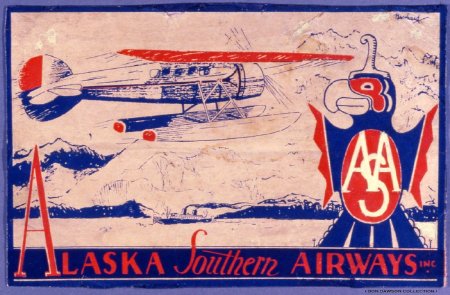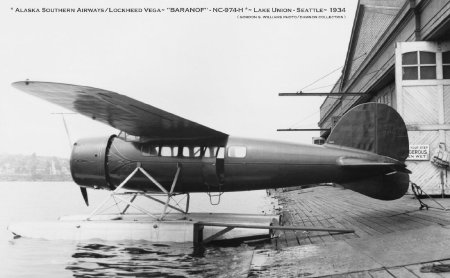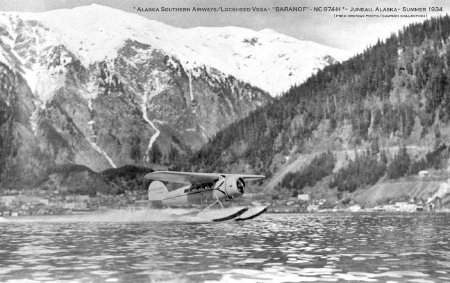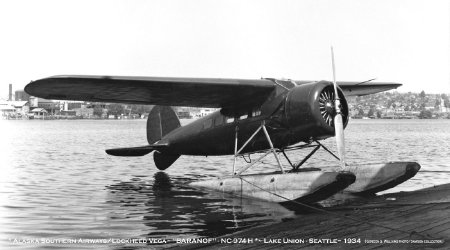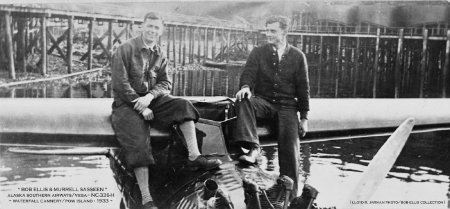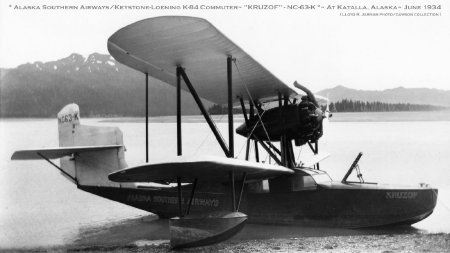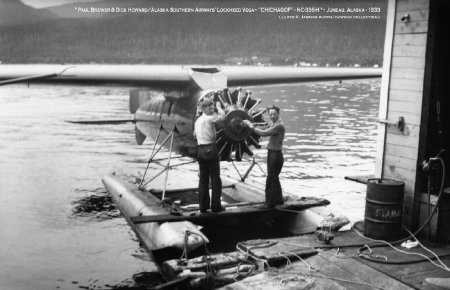Description:
Alaska Southern Airways, 1932-1934
After the demise of Alaska-Washington Airways, Yugoslavian immigrant and Alaska cannery baron Nick Bez, President of Peril Straits Packing Co., founded Alaska Southern Airways on December 15, 1931, and purchased Alaska-Washington Airways' company assets. The acquisition included the two remaining Lockheed Vegas "Chichagof" (NC336H) and "Baranof" (NC974H), and the hangars in Southeast Alaska. Bez hired most all the same cadre of experienced pilots and mechanics to go work for Alaska Southern Airways, and designated Anscel Eckmann as his vice-president and general manager for the new company. Alaska's fishing industry had started benefitting from commercial aviation's pioneer companies. Bez's business decision would ensure his interests would have continued logistical support, while helping keep the local economy vibrant.
On April 5, 1932, Alaska Southern Airways' Vega Chichagof (previously named "Petersburg" NC336H) arrived with Anscel Eckmann as pilot to inaugurate Alaska Southern Airways' service in the Panhandle for the 1932 season. The company transition was relatively seamless for both staff and customers, involving a simple name change repaint of the company name on the planes and signage. Pilot Gene Meyring got the 1933 season underway on April 17, 1933 when he flew Alaska Southern Airways' Vega Baranof into Ketchikan from Seattle. Bob Ellis followed up when he arrived with the Chichagof on June 30, 1933 to have two Alaska Southern Airways planes working the region. Logging its last flight of the season on September 28, 1933, Ellis and mechanic Lloyd Jarman flew Chichagof back to Seattle carrying the first official U.S. Mail from Alaska to Seattle. At the end of September, Alaska Southern Airways bought a Keystone-Loening K-84 Commuter flying boat that was dubbed "Kruzof" (N63K), increasing the fleet to three planes. On October 28, 1933, Alaska Southern Airways' Vega Baranof flew back south to end their good 1933 season.
In early spring of 1934, Alaska Southern Airways announced its plans to operate all three of their planes that season in Southeast Alaska: the Vega Chichagof based in Ketchikan with pilot Bob Ellis; the Vega Baranof based in Juneau with pilot Gene Meyring; and the Commuter Kruzof based in Cordova with pilot Alex Holden. On March 31, 1934, Meyring and mechanic Gordon Graham arrived in Juneau with the Baranof to resume service. On May 7, Bob Ellis followed suit with the Chichagof headed to Ketchikan and on May 17, Alex Holden brought up the Kruzof headed for Cordova. Later in September, Alaska Southern Airways purchased a Fairchild 71 pontoon seaplane dubbed the "Pribilof" (NC-142H) to join the Kruzof in Cordova. It arrived in Juneau on September 17 with Ellis at the controls. Alaska Southern Airways now had four aircraft operating in Southeast Alaska. 1934 looked to be Alaska's biggest year of successful operations, but fate once again deemed otherwise.
On October 10, 1934, Alaska Southern Airways' Vega Baranof (NC974H) was destroyed in a crash near Pinta Bay on Chichagof Island while making a charter flight from Juneau via Hoonah with pilot Gene Meyring, mechanic Lloyd Jarman, and two passengers aboard. All were injured and one passenger was lost. Juneau pilot Shell Simmons, accompanied by mechanics Dick Howard and Clarence Johansen, rescued the survivors in his PATCO Stinson. The tragic accident forced Nick Bez's Alaska Southern Airways out of business. On November 13, 1934, Pacific Alaska Airways (Pan American Airways' subsidiary) purchased Alaska Southern Airways' routes and all three remaining aircraft (Chichagof, Pribilof, and Kruzof). Alaska Southern Airways dissolved its remaining assets that December. Nicknamed "The Sultan of Salmon," Nick Bez's financial empire included fishing fleets, canneries, airlines and several corporations. He was later board chairman for Air West, and died February 5, 1969 in Seattle at the age of 73.
Aircraft Specifications:
5-place and 7-place Lockheed 5C Vega Seaplane on Edo Mod. 4650 floats. 1927 High-wing monoplane design. First Flight: 7/4/27. 64 Mod. 5Cs built, 132 built (all variants). Construction: Wooden monocoque fuselage (wood ribs), laminated plywood construction, single spar cantilever wings, with fabric covered flying surfaces. Dimensions: Length: 27' 6"; Height: 8' 6" (Landplane); Wingspan: 41' 9"; Wing Area: 275 sq. ft. Weights: Standard Empty Weight: 3,153 lbs.; Gross Weight: 4,880 lbs.; Useful Load: 1,000 lbs. Fuel Capacity: 160 gal. Performance: Airspeed: 160 mph cruise, 175 mph max; Service Ceiling: 17,000 ft.; Rate of Climb: 1,100 ft. per min.; Range: 620 mi. (Note: Performance figures with NACA Cowling). Engine: Air-cooled 9 Cylinder 450 hp Pratt and Whitney R-1340 Wasp SC1. Propeller: Hamilton Standard 2-Blade Fixed-Pitch. Occupancy: Pilot: 1; Passengers: 5-7.
4-place Keystone-Loening K-84 Commuter, 1929. First Flight: 9/4/29. 40 built (Flying Boat and Amphibian variants). Note: Keystone-Loening K-84 Commuter "Kruzof" (N63K) on display at the Golden Wings Flying Museum in Minneapolis, MN. Dimensions: Length: 32' 5"; Height: 13' 6" (on landing gear); Wingspan: 36'. Weights: Standard Empty Weight: 2,780 lbs.; Gross Weight: 4,000 lbs. Performance: Airspeed: 116 mph max, 96 mph cruise, 50 mph stall; Service Ceiling: 9,800 ft.; Range 510 mi. Engine: 9 Cylinder 300 hp Wright J-6 Whirlwind Radial. Occupancy: Pilot: 1; Passengers: 3.
Pilots:
Anscel Eckmann, Bob Ellis, Gene Meyring, Alex Holden, and Murray Stuart.
Mechanics:
Lloyd Jarman, Gordon Graham, Murrell Sasseen, Chandler Hicks, Paul Brewer, and Dick Howard.
On April 5, 1932, Alaska Southern Airways' Vega Chichagof (previously named "Petersburg" NC336H) arrived with Anscel Eckmann as pilot to inaugurate Alaska Southern Airways' service in the Panhandle for the 1932 season. The company transition was relatively seamless for both staff and customers, involving a simple name change repaint of the company name on the planes and signage. Pilot Gene Meyring got the 1933 season underway on April 17, 1933 when he flew Alaska Southern Airways' Vega Baranof into Ketchikan from Seattle. Bob Ellis followed up when he arrived with the Chichagof on June 30, 1933 to have two Alaska Southern Airways planes working the region. Logging its last flight of the season on September 28, 1933, Ellis and mechanic Lloyd Jarman flew Chichagof back to Seattle carrying the first official U.S. Mail from Alaska to Seattle. At the end of September, Alaska Southern Airways bought a Keystone-Loening K-84 Commuter flying boat that was dubbed "Kruzof" (N63K), increasing the fleet to three planes. On October 28, 1933, Alaska Southern Airways' Vega Baranof flew back south to end their good 1933 season.
In early spring of 1934, Alaska Southern Airways announced its plans to operate all three of their planes that season in Southeast Alaska: the Vega Chichagof based in Ketchikan with pilot Bob Ellis; the Vega Baranof based in Juneau with pilot Gene Meyring; and the Commuter Kruzof based in Cordova with pilot Alex Holden. On March 31, 1934, Meyring and mechanic Gordon Graham arrived in Juneau with the Baranof to resume service. On May 7, Bob Ellis followed suit with the Chichagof headed to Ketchikan and on May 17, Alex Holden brought up the Kruzof headed for Cordova. Later in September, Alaska Southern Airways purchased a Fairchild 71 pontoon seaplane dubbed the "Pribilof" (NC-142H) to join the Kruzof in Cordova. It arrived in Juneau on September 17 with Ellis at the controls. Alaska Southern Airways now had four aircraft operating in Southeast Alaska. 1934 looked to be Alaska's biggest year of successful operations, but fate once again deemed otherwise.
On October 10, 1934, Alaska Southern Airways' Vega Baranof (NC974H) was destroyed in a crash near Pinta Bay on Chichagof Island while making a charter flight from Juneau via Hoonah with pilot Gene Meyring, mechanic Lloyd Jarman, and two passengers aboard. All were injured and one passenger was lost. Juneau pilot Shell Simmons, accompanied by mechanics Dick Howard and Clarence Johansen, rescued the survivors in his PATCO Stinson. The tragic accident forced Nick Bez's Alaska Southern Airways out of business. On November 13, 1934, Pacific Alaska Airways (Pan American Airways' subsidiary) purchased Alaska Southern Airways' routes and all three remaining aircraft (Chichagof, Pribilof, and Kruzof). Alaska Southern Airways dissolved its remaining assets that December. Nicknamed "The Sultan of Salmon," Nick Bez's financial empire included fishing fleets, canneries, airlines and several corporations. He was later board chairman for Air West, and died February 5, 1969 in Seattle at the age of 73.
Aircraft Specifications:
5-place and 7-place Lockheed 5C Vega Seaplane on Edo Mod. 4650 floats. 1927 High-wing monoplane design. First Flight: 7/4/27. 64 Mod. 5Cs built, 132 built (all variants). Construction: Wooden monocoque fuselage (wood ribs), laminated plywood construction, single spar cantilever wings, with fabric covered flying surfaces. Dimensions: Length: 27' 6"; Height: 8' 6" (Landplane); Wingspan: 41' 9"; Wing Area: 275 sq. ft. Weights: Standard Empty Weight: 3,153 lbs.; Gross Weight: 4,880 lbs.; Useful Load: 1,000 lbs. Fuel Capacity: 160 gal. Performance: Airspeed: 160 mph cruise, 175 mph max; Service Ceiling: 17,000 ft.; Rate of Climb: 1,100 ft. per min.; Range: 620 mi. (Note: Performance figures with NACA Cowling). Engine: Air-cooled 9 Cylinder 450 hp Pratt and Whitney R-1340 Wasp SC1. Propeller: Hamilton Standard 2-Blade Fixed-Pitch. Occupancy: Pilot: 1; Passengers: 5-7.
4-place Keystone-Loening K-84 Commuter, 1929. First Flight: 9/4/29. 40 built (Flying Boat and Amphibian variants). Note: Keystone-Loening K-84 Commuter "Kruzof" (N63K) on display at the Golden Wings Flying Museum in Minneapolis, MN. Dimensions: Length: 32' 5"; Height: 13' 6" (on landing gear); Wingspan: 36'. Weights: Standard Empty Weight: 2,780 lbs.; Gross Weight: 4,000 lbs. Performance: Airspeed: 116 mph max, 96 mph cruise, 50 mph stall; Service Ceiling: 9,800 ft.; Range 510 mi. Engine: 9 Cylinder 300 hp Wright J-6 Whirlwind Radial. Occupancy: Pilot: 1; Passengers: 3.
Pilots:
Anscel Eckmann, Bob Ellis, Gene Meyring, Alex Holden, and Murray Stuart.
Mechanics:
Lloyd Jarman, Gordon Graham, Murrell Sasseen, Chandler Hicks, Paul Brewer, and Dick Howard.
Click to Enlarge

